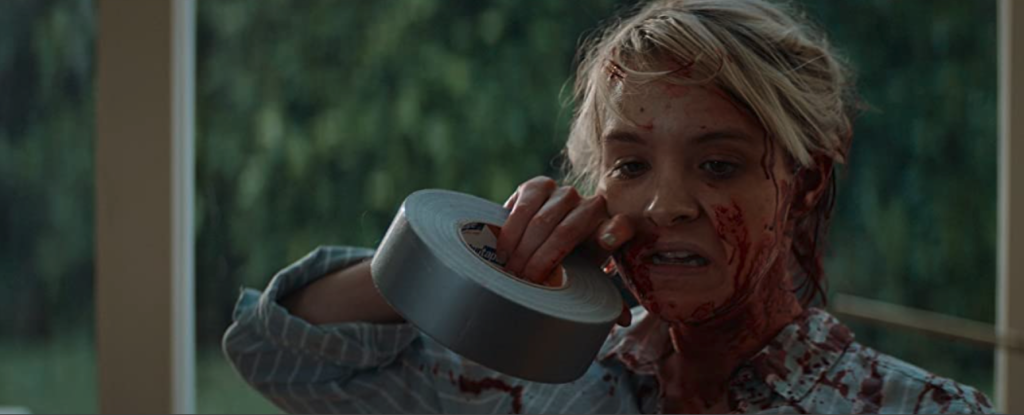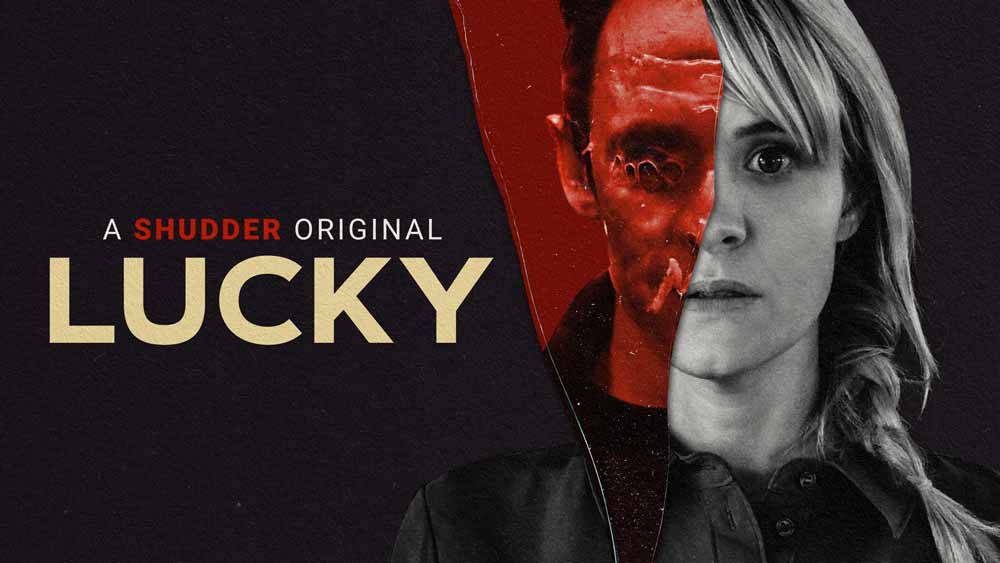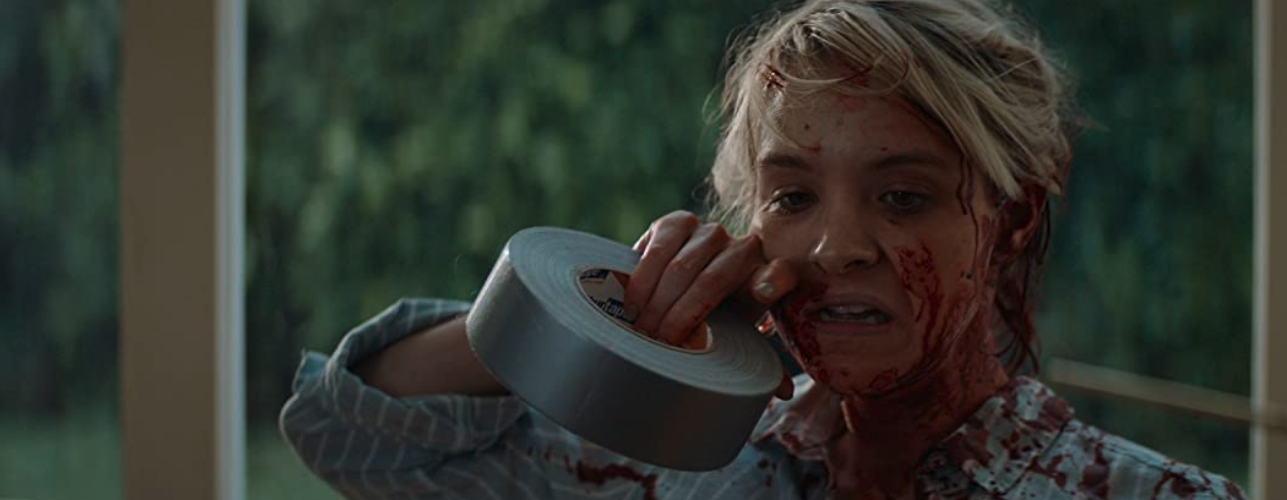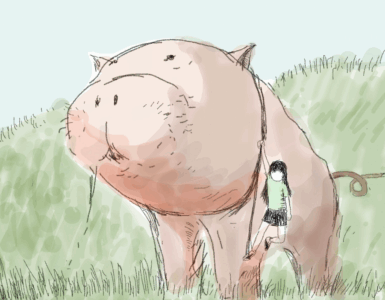
The use of genre films to deliver a social or political statement has a long history. They’re a convenient delivery device – the audience knows the rules, and without hitting them over the head with a heavy-handed message, the familiar story can reveal something deeper. A prime example of this type of movie is George Romero’s Dawn of the Dead, which, while certainly enjoyable as a kickass zombie thriller, is also a pointed critique of consumerism. The new film, Lucky, (on Shudder and Amazon Prime) is an excellent example of this type of filmmaking, working effectively both as a stalker-type horror film and in depicting the true-life horrors of male violence against women. It’s also one of the best films of the year.
May Ryer (Brea Grant) is a moderately successful self-help author, whose book “Go It Alone” somewhat represents her own personal philosophy towards life. While she’s seen as an icon of self-sufficiency to her fans, her actual life is less perfect – her publishers have decided not to accept her latest book, and her relationship with her husband Ted (Dhruv Uday Singh) has become unsteady after an incident of infidelity. Things take a turn for the worse, however, when one evening, while in bed with Ted, she hears the sound of someone breaking into their house. When she asks Ted what he thinks it is, he responds matter-of-factly, “Honey, that’s the man. The man who comes every night and tries to kill us.”
I’m not giving much away by revealing that, as it happens about seven minutes into the film. But I’ll try to avoid spoilers until the very end of this review, and will put up a spoiler alert first. This movie is strong enough that even if you know exactly what it’s about, it’s still very enjoyable, but going into it fresh would provide a more satisfying experience.
Playing the central protagonist, Brea Grant is a veteran of many indie horror films. Delivering fine performances for years now, she’s never given a better performance than the one she shows here. Grant is fierce and vulnerable and utterly convincing as May, a woman forced to the limits of her endurance. It’s a joy to watch a performer you already liked find the right role and just blaze into greatness, which is partly a joy of seeing anyone connect up with their true, possibly unexpected, potential. Simply put, Grant knocks it out of the park.
Singh is quietly effective as Ted, somewhat laissez-faire about people trying to murder himself and his wife, and he manages to make his character’s intentions mysterious in a compelling way. Larry Cedar, reliably good as always, is convincingly irritating as an unhelpful detective. It’s also a treat for indie horror fans to see scare flick stalwarts Chase Williamson and Jesse Merlin appear in an especially surreal scene that suddenly starts turning into a musical.
Natasha Kermani’s direction is smart and assured, taking an already inspired script by Grant and supporting and amplifying it on every level. Upon my second viewing of the film, I started noticing how the color blue shows up absolutely everywhere, from men’s clothing to cars to frowny cupcakes and finally May herself. I’m not certain of a specific symbolic meaning here, but it’s definitely an intentional choice that subconsciously adds to the mounting tension of the piece. A garage set-piece at the movie’s conclusion is conceptually brilliant, but Kermani impressively takes that idea and makes a thrilling cinematic moment of it.
Cinematographer Julia Swain brings a crisp, professional look to the film, ably abetted by Lindsay Minnich’s wonderfully detailed production design. Jeremy Zuckerman’s music helps create a sense of unreality and anxiety, particularly in a recurring motif where low, hooting voices rising in volume (usually combined with May’s stressed breathing) generally presages the appearances of the killer.
SPOILER ALERT –
Grant’s screenplay is amazing on several levels, mainly for its audacious concept, but also for presenting intelligent adult characters who have careers that are actually integral to the plot and not just window dressing for a standard thriller. May is a fully realized person with layers to her personality. She’s not just a tough professional writer. It turns out that she can really defend herself, and when the killer arrives again and again, she dispatches him each time. Even though she proves exceptionally resilient and resourceful, like everyone else she too has a breaking point, and she finally shows her vulnerability.
Grant cleverly uses the horror trope of the killer who can never truly be killed, merely briefly halted, to superb advantage. May stabs her assailant in the heart, he falls dead, she looks away, and then he’s gone. He returns, at first every night, but then during the day, anywhere, anytime. This is plenty to be working with for the usual horror film, but here Grant is using it as a metaphor for the unending threat of male violence against women. It’s an awful reality that women have to be careful all the time to protect themselves from potential assailants. As one character puts it in the film, “Always be vigilant, a man could appear at any time.” And how existentially horrific is that?
Grant has said that her inspiration for the story came partly from a stalker event in her own life, so it’s no surprise that the frustration and desperation feel very real. The police are ineffective or insulting. Her friends and professional associates seem to accept that this is just the way life is – men will keep attacking women and there is nothing to be done about it. More galling is how everyone exclaims to May how “lucky” she is, as if her writing career was something she was gifted with instead of something she earned through hard work, and—of course—how lucky she is not to have been murdered yet. At one late point in the film, in which it’s apparent that this nightmarish situation is similarly affecting every other woman she knows, May declares that they’re just going to be attacked everywhere every day for the rest of their lives. She asks, “I don’t know what I did to deserve this, do you?”
The recent film release Promising Young Woman shares thematic similarities to Lucky. While the former uses the tropes of the revenge drama, both films share a righteous anger about a culture that permits violence against women to be a constant threat. Woman was rightfully praised earlier this year, but Lucky is equally deserving of acclaim. It’s one of the most original, powerful films of the year.
In their 1993 album, Pale Sun, Crescent Moon, the band Cowboy Junkies wrote a song called “Hunted,” about all the things women have to do to try and stay safe. Lucky reminds me of the lyrics in the song, where the question is asked: “Do you know what it’s like to be hunted?” Sadly, almost thirty years on, the answer is still: Yeah. They do.
– Terry Morgan
Lucky — directed by Natasha Kermani — is now available for viewing on Shudder and Amazon Prime.






